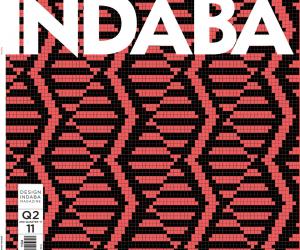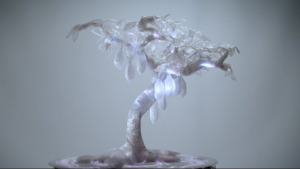First Published in
Zander Blom is proud to live in the never-quite-gentrified suburb of Brixton in Johannesburg. His house, described as a “soiled hamster cage” by Vice magazine, is allegedly knee-deep in the effluent sawdust of an overactive creative mind. “Books, sheets of paper, collages, references torn from books, canvas, oil paint, cardboard constructions, music instruments…” the somewhat starved-looking 29-year-old explains. With the bravado of a tortured artistic soul, he adds: “I can’t think of a more perfect way to live.”
This house has become the living, constantly evolving three-dimensional canvas captured on camera for his genre challenging exhibitions The Drain of Progress (2007) and The Travels of Bad (2009). In 2009 he was included in the Younger Than Jesus artist directory published by the New Museum, New York, and awarded a Red Bull House of Art residency in São Paulo in 2009. He presented his first solo show at the Michael Stevenson Gallery, Paintings, Drawings, Photos, in 2010. Since then he has exhibited in Berlin, Antwerp and New York.
As an art school dropout you’re something of an upstart to the traditional art institution. Can you describe your trajectory since leaving the University of Pretoria in second year?
After matriculating at Pro Arte Alphen Park art school in Pretoria I went to study information design. It was the responsible thing to do. After two years in the course I couldn’t force myself to do it anymore. Since I can remember, the only thing that I really wanted to do with my life was spend it making art. I realised that I would rather starve doing that than make a comfortable living doing anything else. So I dropped out. I had been making my own work independent of my studies since I could remember and had been exhibiting on little independent exhibitions with friends since high school. So it wasn’t a new thing, I could just finally do it full time.
At the time I was living and working in a double garage at my parents’ house in Pretoria. Shortly after dropping out, I moved to Johannesburg, where I rented a room in my friend Adriaan Hugo’s house in Brixton. I had a single mattress and very little money. I could only afford to work with ink and paper. Together with friends I organised and participated in a couple of little group shows at whatever spaces we could find. I met Michael MacGarry and Jan-Henri Booyens, and we started Avant Car Guard. I met Stephen Hobbs and Marcus Neustetter, who gave me my first two solo shows at their Premises Gallery in Braamfontein.
At this time Whatiftheworld gave me a call, so I loaded the second show in the back of my bakkie and drove it down to Cape Town. At the same time Gavin Rooke, whom I met while at university, started getting involved in art. I was working on The Drain of Progress book at the time and he jumped on board. He put me on the group show TEN and shortly after that he opened up his own gallery. I did two solo shows and two publications with the Rooke Gallery (The Drain of Progress and The Travels of Bad), which we also sent down to Whatiftheworld. Parts of these two bodies of work were included on group shows abroad. In 2009 I met Jaco van Schalkwyk and we started the band Jaco + Z-dog.
At the end of 2009 I decided to break away from the Rooke Gallery and Whatiftheworld. We had a good run but, for a variety of reasons I needed to move on. I cut my ties and went on a residency in Brazil. When I came back I started working with the Michael Stevenson Gallery.
They had expressed interested in working with me before and I decided to take them up on the offer. I was working on a couple of new bodies of work including a long-term oil painting project, a drawing project and a new photographic series. We did my first solo exhibition together at the end of 2010. I also went to Germany for two exhibitions and sent some work to Antwerp in 2010. This year Michael Stevenson also took some of my paintings to Armory in New York.
There you have an incredibly simplified account of the past decade of my life.
You have repeatedly stated that your work is a mediation of how you understand Modernism living in Johannesburg in the 21st century. So how do you understand Modernism living in Johannesburg in the 21st century? Not all my work is caught up with the legacy of Modernism, but it is a particular point of interest. I’m a bit of a self-inflicted scholar or enthusiast of art history. To me it’s a very enjoyable subject for private study and Modernism is a vital part of it. The relationship between the reality of my life and Modernism in art is simple: Take a look at the books on your shelves and then take a look out your window. What do you see?
Your initial success through The Drain of Progress had everyone convinced of your abstract intentions, however The Travels of Bad took your work into a narrative direction. What personally attracted you to the mythology of the European Primitivist?
With The Drain of Progress I found myself working backwards through Modernism. Eventually I got to Gauguin, Van Gogh, Rousseau, Picasso, Matisse, etc. I became very interested in the notion of the exotic, the primitive, “the Other” and the influence it had on Modernism. This demanded a very different kind of thesis. Where The Drain of Progress looked at the notion of progress in European and North American art of the early 20th century, The Travels of Bad looked at the influences of exotic cultures and their artefacts on European art of the late 19th and early 20th centuries.
Turning your house into a fleeting, continuously changing installation project has drawn comparisons with Kurt Schwitters’s Merzbau. Was this a conscious reference point? Are you “keeping it real” and still living in this house?
Yes, Schwitters was a particular point of interest when I was working on The Drain of Progress – there’s a reference image of Merzbau on page 124 of the book.
And I still live in Brixton. The house is even more chaotic and messy these days because of all the oil paint and canvas. But it’s hardly about “keeping it real”. I’m making art for myself; my private experience of making the work and learning from that experience is the most important part of being an artist to me. I construct environments that I find agreeable to live, work and think in. The space is cluttered with books, sheets of paper, collages, references torn from books, canvas, oil paint, cardboard constructions, music instruments etc. I can’t think of a more perfect way to live.
Your most recent show at the Michael Stevenson Gallery – Paintings, Drawings, Photos – was not the first time you picked up a paintbrush, but it was the first time that you showed your paintings unmediated by your camera. Is it safer to be behind your camera?
I wanted to be a painter since I first came into contact with art as a child. That desire never left me, I’ve studied it and experimented with it for a long time. I’ve been working my way towards it since I started doing art. I’ve done lots of photographic work, printmaking, installation and drawing over the years, and I left oil painting alone until I was sure what I wanted to do with it. It’s not that it’s a more difficult medium than the others; it has to do with the weight that I allowed art history to prescribe to the medium in my own mind. For a long time painting was this massive untouchable monolith that towered above me. This holy thing, locked in history, this thing that belonged in books and museums some place across the ocean, far away. But I got over that bullshit eventually and now I can finally add oil painting to my repertoire.
Paintings, Drawings, Photos is allegedly three new bodies of work in progress, however they seem like the constituents of your previous work separated out into layers. Where will these bodies of work go and will they reunite?
It is in fact three developing bodies of work that were brought together for an exhibition. The photographs are part of a pseudo minimalist sci-fi noir space film project, called The Black Hole Universe, next in line after The Travels of Bad and The Drain of Progress. The drawings are something that I’m always doing regardless of any other projects and the paintings are a new long-term undertaking. All three have different publications pending. There are obviously links between all of them, because I’m not three separate human beings, but take into account that art to me is above all a form of private study, ultimately a quest for personal growth and enjoyment.















